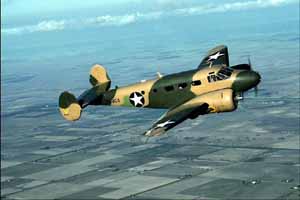Beech C-45 Expeditor
U.S. Light Transport & Trainer
 |
One of the Ghost Squadron's C-45s. Image source: The Confederate Air Force Ghost Squadron CD-ROM produced by Corel. Photos by Bill Crump. |
The Beech Aircraft Corporation’s Model 18 was already a successful light twin-engine six to eight seat commercial transport when the U.S. Army Air Corp ordered a few as C-45s for staff transports. Over the next five years, over 4,000 of the rugged Beech design were purchased by the military and used in a number of roles. Although given the name Expeditor, the C-45 was rarely called by that name. The U.S. Navy also purchased equivalents of the C-45, calling them JRBs.
The first specialized training version of the C-45 was the AT-7 Navigator, which was first ordered in 1941 as a navigation trainer. With a flight crew of two plus three student navigators, about 2,000 AT-7s were produced. Another important training version was the AT-11 Kansan, which was a specialized bombing and gunnery trainer. Equipped with a .30 caliber machine gun in the nose and another in a top turret, plus ten 100 pound practice bombs in its internal bomb bay, the AT-11 served throughout the Second World War as the principal trainer for aerial gunnery and for bombardiers.
The largest Army Air Corp base for bombardier training was located right here in Midland, Texas, at the Midland Army Airfield, which is now the site of the Midland International Airport. During the war, hundreds of AT-11s could be seen on the ramp and in the skies around the Midland/Odessa area.
A less well known variant of the twin Beech design was the AT-10 Wichita, which was a version of the AT-7 constructed mostly of wood and using lighter and less powerful engines. The design resulted from the fear that supplies of some strategic light metals could be halted by the war, and over 2,300 of the AT-10s were built, however, few, if any, survive today in flying condition.
Another special version was the F-2, built to carry two to four aerial cameras and used for reconnaissance and aerial mapping. Only about 70 of the F-2 models were built.
Overall, the C-45 was a very successful adaptation of a commercial design, and versions continued to serve on active duty with the Air Force and Navy more than twenty years after the end of the Second World War.
Specifications
One Pilot and Five Passengers Two Pratt & Whitney R-985-AN-1 Engines Max. Speed 215 mph @ sea level Climb to 10,000 ft in 8.6 minutes |
Length 34' 3" Max. Weight 7,850 lbs Normal Range 700 miles |